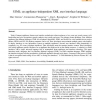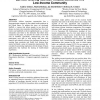SIGKDD
2010
13 years 10 months ago
2010
Mobile devices are becoming increasingly sophisticated and the latest generation of smart cell phones now incorporates many diverse and powerful sensors. These sensors include GPS...
CORR
2008
Springer
14 years 1 months ago
2008
Springer
In this chapter we consider a cell phone network as a set of automatically deployed sensors that records movement and interaction patterns of the population. We discuss methods fo...
CN
1999
14 years 2 months ago
1999
Today's Internet appliances feature user interface technologies almost unknown a few years ago: touch screens, styli, handwriting and voice recognition, speech synthesis, tin...
DIMVA
2006
14 years 4 months ago
2006
Wireless devices that integrate the functionality of PDAs and cell phones are becoming commonplace, making different types of network services available to mobile applications. How...
CSREASAM
2008
14 years 4 months ago
2008
CSCW
2008
ACM
14 years 4 months ago
2008
ACM
Low-income African American communities face a disproportionate amount of diet-related health problems in the United States. To address this issue, we developed EatWell, a system ...
ASSETS
2007
ACM
14 years 7 months ago
2007
ACM
The MobileASL project aims to increase accessibility by enabling Deaf people to communicate over video cell phones in their native language, American Sign Language (ASL). Real-tim...
CHI
2003
ACM
14 years 8 months ago
2003
ACM
With the advent of new technology in vehicles, drivers can access information in many different forms (email, address books, Web pages) and from many information sources (cell pho...
LOCA
2007
Springer
14 years 9 months ago
2007
Springer
Increasingly, cell phones are used to browse for information while location systems assist in gathering information that is most appropriate to the user’s current location. We se...
HICSS
2008
IEEE
14 years 9 months ago
2008
IEEE
: Cell phones are an emerging but rapidly growing area of computer forensics. While cell phones are becoming more like desktop computers functionally, their organization and operat...



